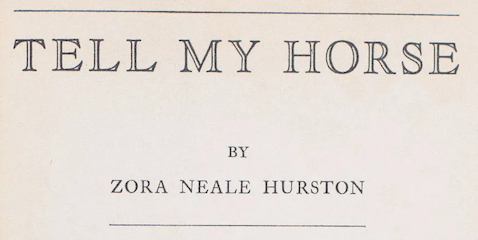
Tell My Horse (Zora Neale Hurston, 1938) – A study of Vodou and cultural traditions in Haiti and Jamaica by Zora Neale Hurston. This book will be made public by Luce Publications on Jan. 1, 2034 when renewed copyright expires.
Tell My Horse: Voodoo and Life in Haiti and Jamaica is a non-fiction book by American author and anthropologist Zora Neale Hurston, first published in 1938 by J.B. Lippincott. Blending travelogue, ethnography, and personal narrative, the work chronicles Hurston’s fieldwork in Jamaica and Haiti during 1936 and 1937, where she explored African diasporic spiritual practices, particularly Vodou (also spelled Voodoo) and Jamaican folk traditions. Written during a pivotal period of Hurston’s career, Tell My Horse reflects her dual roles as a Harlem Renaissance writer and a trained anthropologist, offering a vivid, firsthand account of Caribbean cultures and their resilience against colonial legacies.
Background
Zora Neale Hurston, born in 1891 in Alabama and raised in Eatonville, Florida, was a key figure in the Harlem Renaissance. After studying anthropology at Barnard College under Franz Boas, she received a Guggenheim Fellowship in 1937 to investigate Caribbean folklore. Building on her earlier work, Mules and Men (1935), which documented African-American folklore in the U.S. South, Hurston traveled to Jamaica and Haiti to immerse herself in their spiritual and social worlds. Unlike many anthropologists of her time, she participated in rituals as an initiate, not merely an observer, lending Tell My Horse an intimate perspective.
Content and Structure
The book is divided into three parts:
- Jamaica: This section explores Jamaican culture, including the Maroon community of Accompong, racial dynamics between Black and mulatto populations, and beliefs in “duppies” (spirits). Hurston describes local customs with her characteristic storytelling flair.
- Politics and Personalities of Haiti: Here, Hurston examines Haiti’s political landscape and historical figures, reflecting on the nation’s struggles post-independence and during the U.S. occupation (1915–1934). She critiques the tensions between Haiti’s Black and mulatto elites.
- Voodoo in Haiti: The longest and most celebrated section details Vodou practices, rituals, and deities (loa). Hurston recounts ceremonies, possession experiences, and her encounters with zombies, including a photograph of Felicia Felix-Mentor, whom she identifies as a zombie. She presents Vodou as a legitimate religion rooted in African traditions, countering Western stereotypes.
The book includes 26 black-and-white illustrations, such as photographs and drawings, enhancing its ethnographic richness. Hurston’s prose oscillates between scholarly observation and lyrical narrative, reflecting her dual expertise.
Reception
Upon release, Tell My Horse received mixed reviews. Critics like Alain Locke praised its “piquant thrills” but called it “anthropological gossip,” questioning its scholarly rigor due to its informal tone and genre-blending approach. Newspapers lauded its vividness but noted its unconventional mix of anthropology and travel writing. Anthropologists debated Hurston’s findings, which sometimes diverged from prior studies, yet her insider perspective was acknowledged as groundbreaking. Over time, the book’s reputation grew, with scholars like Ishmael Reed hailing it as a postmodern classic for its fusion of styles and its defense of Vodou’s cultural depth.
Themes and Significance
Tell My Horse explores themes of cultural survival, self-governance, and the interplay of empire and resistance. Hurston portrays Jamaica and Haiti as complex societies shaped by African heritage and colonial histories, offering a nuanced view of Black autonomy. Her empathetic portrayal of Vodou—describing it as “the old, old mysticism of the world in African terms”—challenges racist caricatures, positioning it alongside other global religions. The book also reflects Hurston’s interest in gender, race, and power dynamics, evident in her observations of Caribbean social structures.
As an African-American woman anthropologist, Hurston brought a rare perspective to her field, amplifying marginalized voices. Tell My Horse stands as a testament to her commitment to preserving Black cultural legacies, bridging her literary and ethnographic careers.
Publication and Legacy
Published in October 1938, Tell My Horse followed Hurston’s acclaimed novel Their Eyes Were Watching God (1937). Despite initial modest sales, it has since been reissued multiple times, notably by Harper Perennial in 1990 with a foreword by Ishmael Reed. It is often paired with Mules and Men in collections like the Library of America’s Folklore, Memoirs, & Other Writings (1995). The book’s influence extends to studies of the African diaspora, anthropology, and literature, inspiring courses on Vodou and Caribbean culture. Its copyright, renewed as R379484, expires in the U.S. on December 31, 2033, after which it will enter the public domain.
See Also
- Zora Neale Hurston
- Harlem Renaissance
- Vodou
- African diaspora
- Anthropology